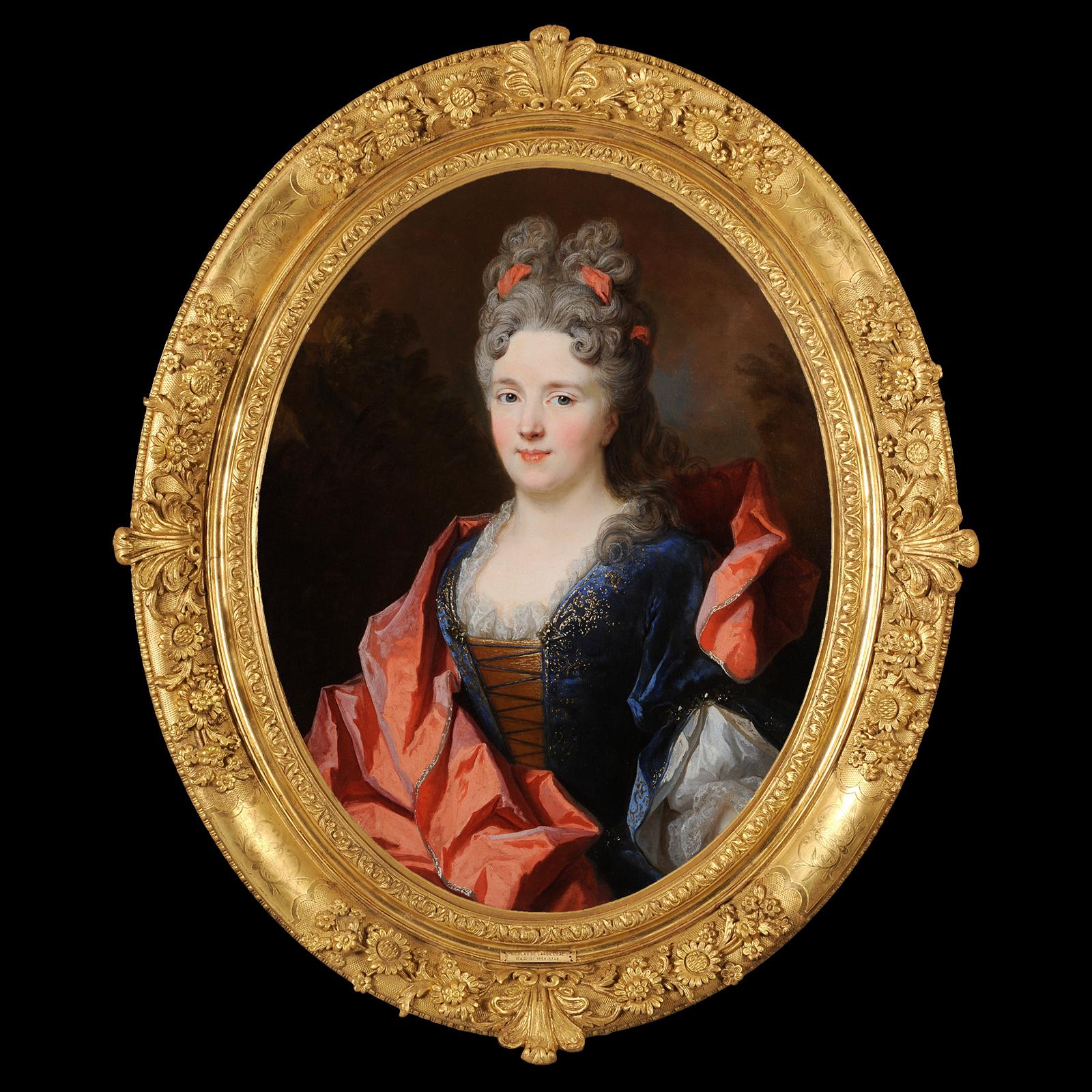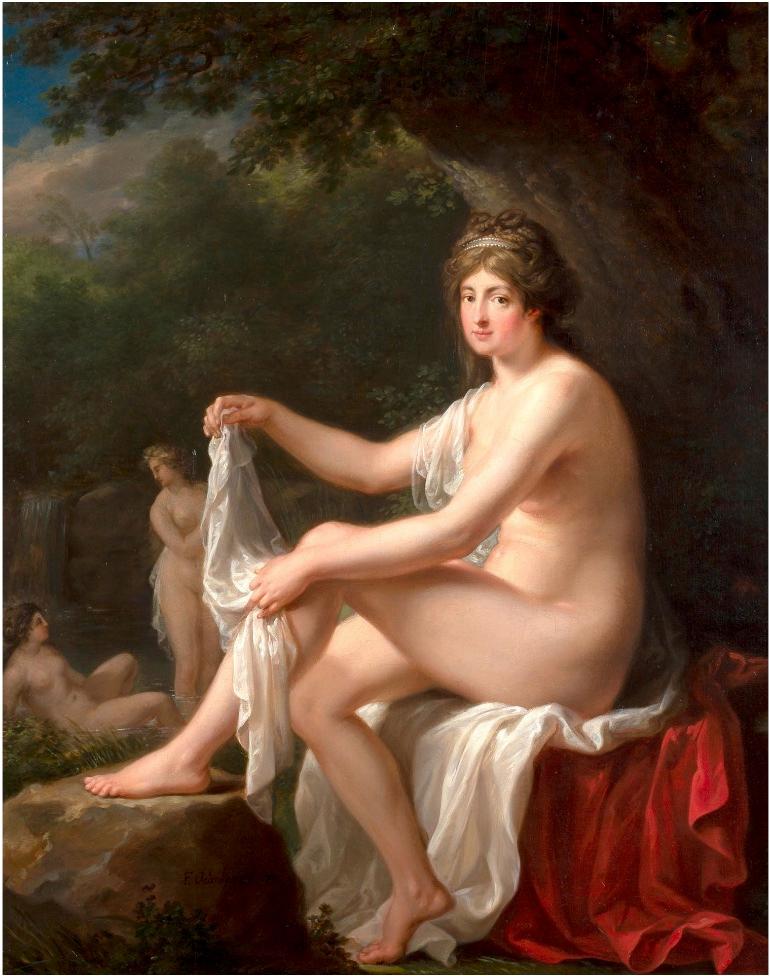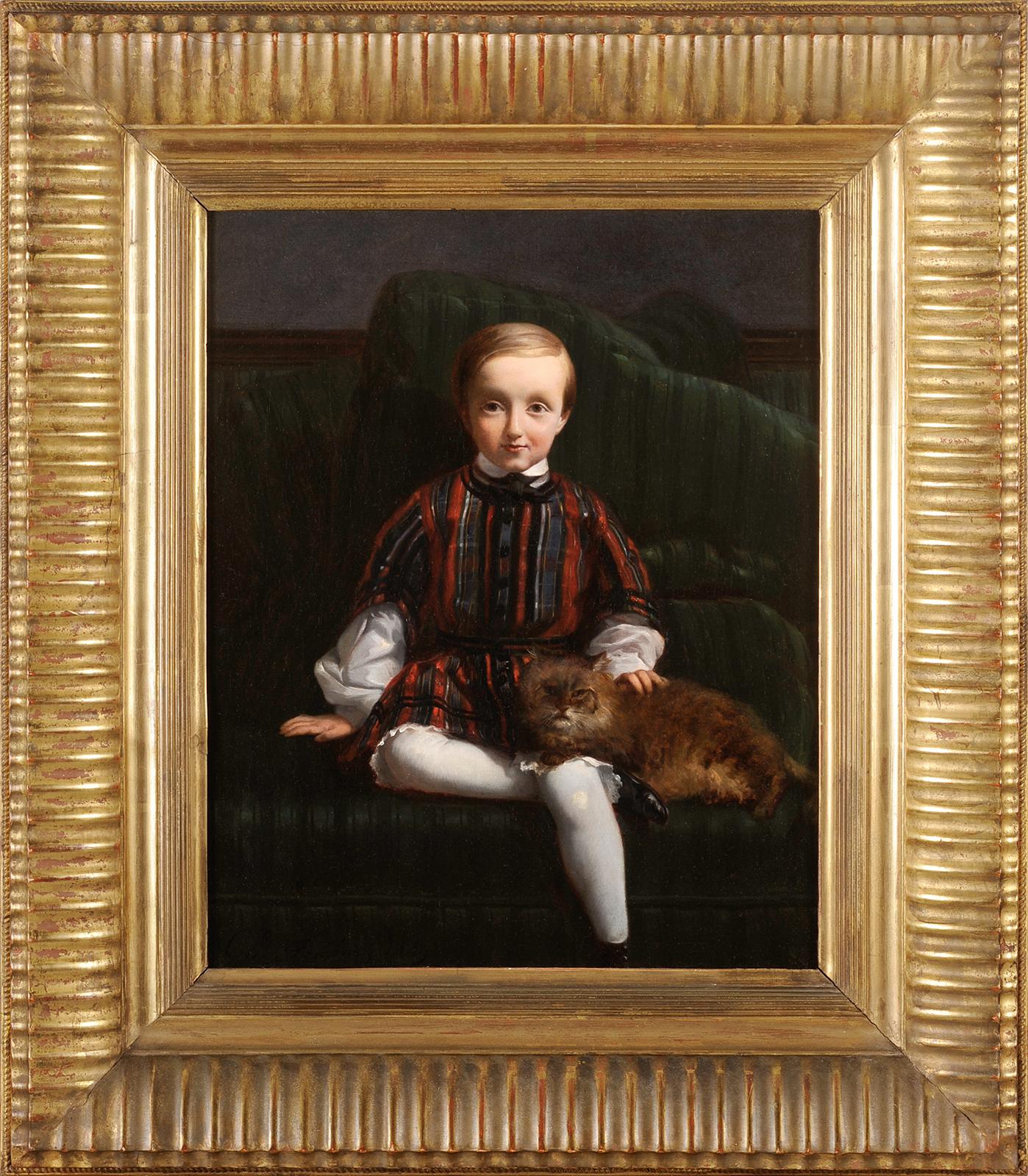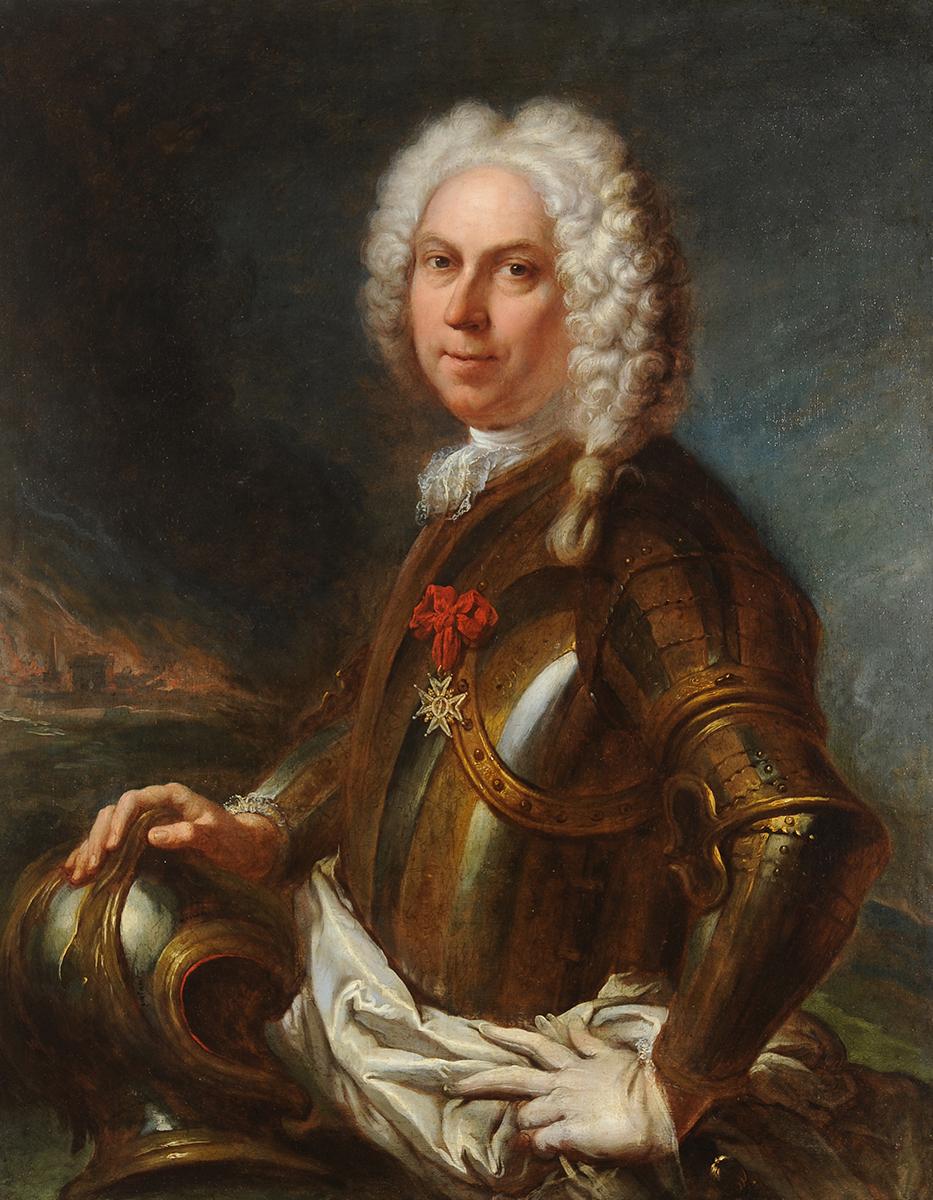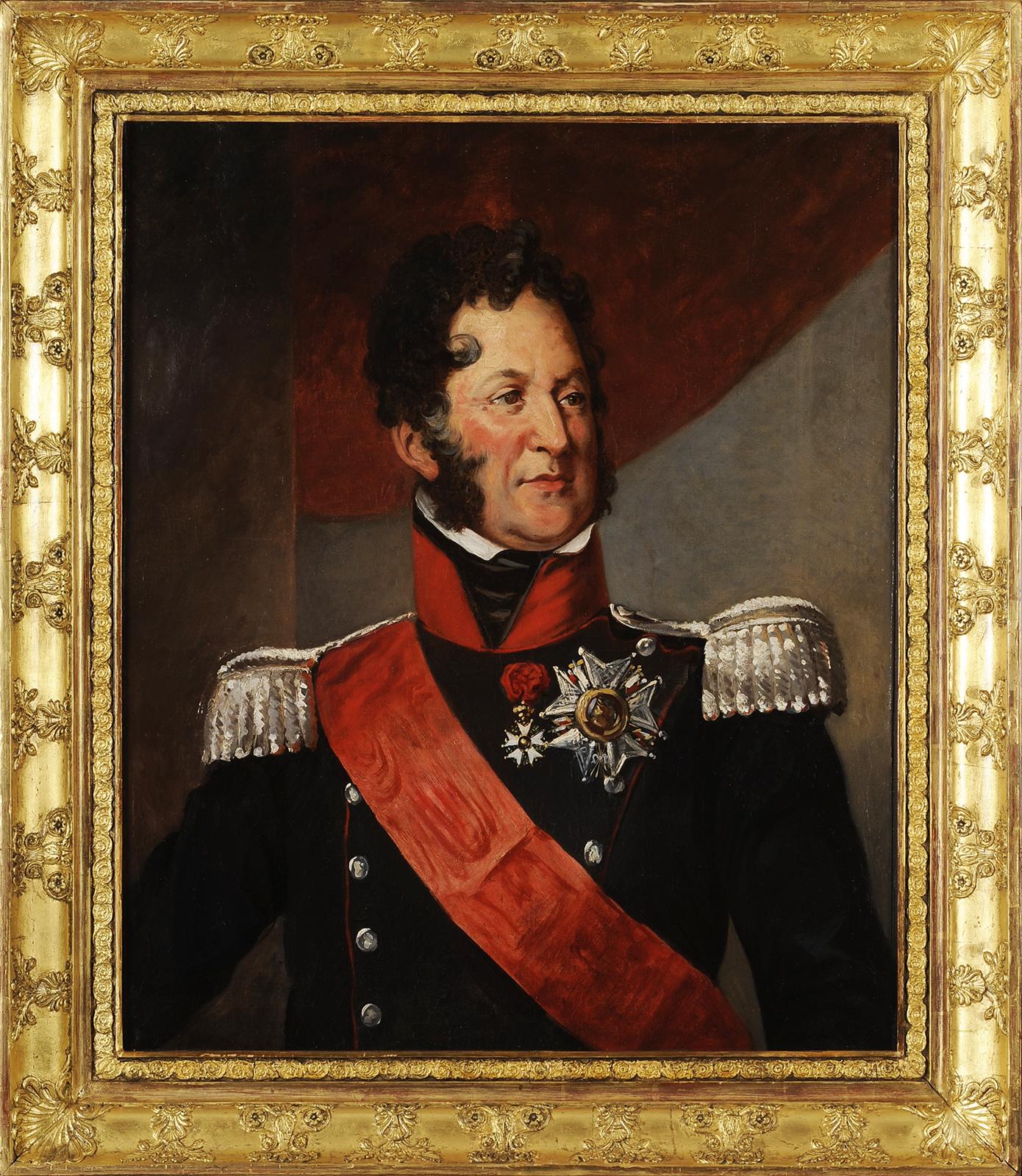Items Similar to Honoré Louis Umbricht, Portrait Of Marguerite Grosjean, Oil Painting
Want more images or videos?
Request additional images or videos from the seller
1 of 13
Honoré Louis UmbrichtHonoré Louis Umbricht, Portrait Of Marguerite Grosjean, Oil Painting c. 1925
c. 1925
About the Item
This early 20th-century oil painting by French artist Honoré Louis Umbricht (1860-1943) depicts Marguerite Grosjean (b. 1895), the daughter of law of Alexandre Grosjean, the mayor of Besançon.
Umbricht was a distinguished painter of genre scenes, landscapes, stills and portraits. Born in the attractive city of Obernai, in the Alsace region of North-East France, he had inspiration at his fingertips. Distant mountains, picturesque valleys, the sparkling Ehn River, and sprawling rural plains - a veritable smorgasbord of views.
He honed his draughtsmanship under the tuition of his uncle, ‘Hess’, and was soon offered a scholarship by the German government to study in Munich. He refused, however, and headed for Paris to train under the highly-regarded Léon Bonnat (1833-1922).
Bonnat’s studio was synonymous with success and he encouraged his students to paint freely and with expression. His own portraits were influenced by the Spanish masters, such as Diego Velázquez (1599-1660), and he extolled the virtues of this style. Umbricht was in fine company as Bonnat also trained John Singer Sargent, P. S. Krøyer, Erik Werenskiold, Henri de Toulouse-Lautrec and Gustave Caillebotte among others.
Following his training, the Paris Salon beckoned and the young Umbricht’s debut came in 1880. By 1884, he’d been awarded his first medal and several more would follow including at the Chicago and London Exhibition and the prestigious Exposition Universelle (1900). He was subsequently knighted with the Cross of the Order of Leopold.
Midway through his career, the critics were alive with praise describing his portraits as “full of mastery” and with “very true and harmonious” colouring. In 1911, the newspaper ‘Le Rappel’ described him as “earning a place among our best portraitists”. His adroit handling of colour was often the highlight of press reviews, rarely dull, he preferred to tantalise the eyes with a lively, yet harmonious palette.
From the 1920s onwards, his career seems to have plateaued, perhaps due to the rise of the avant-garde in Paris. Interest waned in classically inspired works in favour of the emerging modernists. During this later period, he produced numerous portraits for local dignitaries, as we see here. These were full of guile, energy and his trademark effervescence. Each underpinned by his education with Bonnat - the spirit of Velázquez firmly front of mind.
Today, the achievements of Honoré Louis Umbricht are consigned to the archives and rarely do his works surface. He was a traditionalist usurped by new Parisian ideologies. His daughter, Marie-Thérèse Umbricht, also became a painter. He’s represented at various museums including in Nancy and Strasbourg.
The sitter, Marguerite Grosjean, was born in Erstein, Bas-Rhin, Grand Est, France. She was around 30 for this sitting.
Signed in the lower left and held within its original gilt frame.
Labels & Inscriptions: Inscribed on the reverse with a reference to the sitter.
Provenance: Private collection, France.
Artist’s auction maximum: £18,200
Established in 2017, Brave Fine Art is a premier English art dealership based in Cheltenham with clients including national galleries and country estates. Our team includes a conservator, logistics specialist and art historian. Over 1,000 paintings have been transported to the US and Canada safely with hundreds of glowing reviews.
We set our prices fairly from the start as we prefer to sell quickly and continually evolve the collection. Around 40 new discoveries are added every month. If you have any questions at all, we’d love to hear from you.
- Creator:Honoré Louis Umbricht (1860 - 1943, French)
- Creation Year:c. 1925
- Dimensions:Height: 35 in (88.9 cm)Width: 30 in (76.2 cm)
- Medium:
- Movement & Style:
- Period:
- Condition:Assessed and approved by our conservator. Cleaned. Revarnished. Faint stretcher marks. Frame restored.
- Gallery Location:Cheltenham, GB
- Reference Number:1stDibs: LU2328214269022
About the Seller
5.0
Platinum Seller
These expertly vetted sellers are 1stDibs' most experienced sellers and are rated highest by our customers.
Established in 2017
1stDibs seller since 2023
128 sales on 1stDibs
Typical response time: <1 hour
- ShippingRetrieving quote...Ships From: Cheltenham, United Kingdom
- Return PolicyA return for this item may be initiated within 14 days of delivery.
More From This SellerView All
- Bror Kronstrand, Portrait Of Brita Söderberg, Oil PaintingLocated in Cheltenham, GBThis charming portrait by Bror Kronstrand (1875-1950) depicts Brita Söderberg (nee Browall) wearing a light blue blouse with a white hat, ribbon and flower. She was 20 at the time. ...Category
Early 20th Century Academic Portrait Paintings
MaterialsCanvas, Oil
- John JG Blundell, Study Of Man In Profile, Oil PaintingLocated in Cheltenham, GBThis mid-20th-century oil painting by English artist John JG Blundell (1927-2016) depicts a middle-aged man in profile. Every now and then we discover a special piece by an unknown ...Category
1940s Portrait Paintings
MaterialsCanvas, Oil
- Julius Friedländer, Portrait Of The Artist’s Mother, Oil PaintingLocated in Cheltenham, GBThis early 19th-century oil painting by Danish artist Julius Friedländer (1810-1861) depicts his mother, Rebecca Friedländer (1777-1858). Friedländer was predominantly a genre paint...Category
1830s Portrait Paintings
MaterialsCanvas, Oil, Wood Panel
- Johann Paul Eisenmeyer, Portrait Of A Gentleman, Oil PaintingLocated in Cheltenham, GBThis charming mid-19th-century oil painting by Austrian artist Johann Paul Eisenmeyer (act.1820-1846) depicts a gentleman wearing a black coat, white shirt and black bowtie. Eisenme...Category
1840s Folk Art Portrait Paintings
MaterialsCanvas, Oil
- Thornton Rippingille, Portrait Of The Inventor Thomas Dunn, Oil PaintingLocated in Cheltenham, GBThis mid-19th-century oil painting by English artist Thornton Rippingille (1830-1863) depicts the inventor Thomas Dunn. Dunn was a remarkable Lancastrian who pioneered new technolog...Category
1850s English School Portrait Paintings
MaterialsCanvas, Oil, Board
- William Arthur Breakspeare RBA RBSA ROI, The Captain Of The GuardBy William Arthur BreakspeareLocated in Cheltenham, GBThis early 20th-century oil painting by British artist William Arthur Breakspeare RBA RBSA ROI (1855-1914) depicts an upstanding self-assured cavalier with his arms folded. Breakspe...Category
Early 1900s Victorian Portrait Paintings
MaterialsCanvas, Oil
You May Also Like
- Model undressingLocated in BELEYMAS, FRJulius EXNER (Copenhagen, 1825 - Copenhagen, 1910) Model stripping Oil on canvas H. 122 cm; L. 74 cm Signed and dated 1842 lower right Exhibition: most likely Charlottenborg Salon of 1845, under number 110, titled Modelfigur, awarded with a silver medal Provenance: Emilio Fernando Bolt (c.1860 - 1944), acquired from the artist around 1900, then by descent Our painting was produced as part of the summer sessions organized between 1839 and 1850 by Christoffer Wilhelm Eckersberg (1783-1853), the master of Danish painting of the first half of the 19th century, in his private studio-apartment on the ground floor. floor at the Royal Academy of Fine Arts in Copenhagen. The master brought together a few students there between June and September, rented one or two models for the season, which were painted from different angles, the artists (including Eckersberg himself) sitting side by side. Eckersberg used to paint a fairly small version, the pupils of the larger formats. The work fits more generally into the legendary context of the research and reforms carried out by Eckersberg concerning the studies of nudes and in particular of female nudes, to make this exercise a genre of painting in its own right. Following his two-year stint in Jacques-Louis David's studio in Paris in 1811, Eckersberg had been made aware of work on the nude and in particular on live models, in natural light, while in Denmark the drawings were then only made from casts of antique models or other mannequins. In 1822, when he had been a professor there since 1818, it was he who had the Royal Academy of Copenhagen authorize the study of nudes, no longer in the evening by candlelight, but in natural light; from 1833, it was still he who allowed students to work on nude female models, even if the official authorization of the Academy did not take place until 1839. It was this same year that he instituted his summer sessions, on a private basis, to orient his painting and that of his students towards a new conception of the representation of models: even if the nude remains the real theme, it does not however, this is more than just an academic exercise. The subject is placed in a contemporary interior, with a rather sophisticated decor, and occupied with an intimate activity (it is this type of intimate vein that we will find later in Degas or Cassatt for example); thus in our painting, the young woman is supposed to take off her clothes to wash. The objective is that the viewer forgets that the master and his students are painting a model during a posing session, and that he instead has the impression of being alone with the model, but invisible, almost like a voyeur in spite of himself. Moreover, in these paintings, the model never looks towards the spectator, inducing a psychological distance with him, whereas model and artist are actually physically very close. On the other hand, it is not a question of idealized nudes either, even if Eckersberg, proof of his debt to the antique, chooses fairly classic models and poses. The sensuality is real and very present, with dreamy, even innocent, and timeless expressions (the models do not seem to have a defined age), suave and slow attitudes and movements, and especially with clothes that hide or reveal skillfully parts of the female body: upper buttocks, pronounced hips... Made by an artist under 20, our sensual painting is probably one of the most beautiful and spectacular produced by the students of Eckersberg during these summer sessions. With a perfect balance between the firmness of an ancient statue (it recalls the Venus de Milo) and the softness of the feminine forms, highlighted by a harmonious palette, it captures the attention with many details: the almost photographic folds white clothing...Category
1840s French School Nude Paintings
MaterialsCanvas, Oil
- Presumed portrait of Princess de Conti, Marie-Anne de BourbonBy Nicolas de LargillièreLocated in BELEYMAS, FRNicolas de LARGILLIERRE (Paris 1656 – 1746) Portrait of a woman, presumed to be Marie-Anne de Bourbon, Princess of Conti (1666-1739) Oil on oval canvas H. 80 cm; L. 61 cm (107 x 91 c...Category
1730s French School Figurative Paintings
MaterialsCanvas, Oil
- Diana Bathing 18th Century Oil on Canvas by Friedrich Olenhanz 1765-1839Located in LA BOUILLE, FR"As the incarnate of dawn shines in the morning, such a blushed Diane's complexion exposed without veils to the eyes of a mortal" Les Métamorphoses by Ovide Less tragic is our destin...Category
18th Century French School Paintings
MaterialsCanvas, Oil
- Sketch of a dandy portraitLocated in BELEYMAS, FRFrench school circa 1840 Sketch of a dandy portrait Oil on canvas mounted on cardboard H. 21 cm; L. 20.5 cmCategory
1830s French School Figurative Paintings
MaterialsCanvas, Oil
- Portrait of a man in armorLocated in BELEYMAS, FRAttributed to Jacques DUMONT aka DUMONT LE ROMAIN (Paris 1701 - 1781) Presumed portrait of Louis-Joseph de Formanoir (?-1732) Oil on canvas H. 91.5 cm; ...Category
1750s French School Figurative Paintings
MaterialsCanvas, Oil
- Charles Fréchou - Child portrait with a catLocated in BELEYMAS, FRCharles FRÉCHOU (Paris 1820 – Paris 1900) Portrait of a child with a cat Oil on canvas H. 41 cm; L. 33 cm Signed lower left and dated 1849 Apart from participation in the Salon betw...Category
1810s French School Figurative Paintings
MaterialsCanvas, Oil

